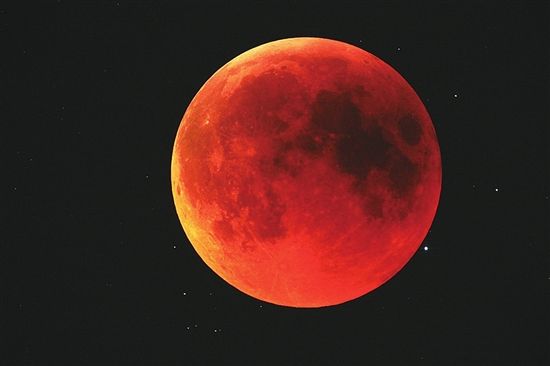(单词翻译:单击)
听力文本
This is Scientific American — 60-Second Science. I'm Christopher Intagliata.
This weekend, many parts of the world—including North America—will be treated to a total lunar eclipse. So here with your viewing guide—how it happens, what to expect, and when to head outside—is Michelle Nichols, Director of Public Observing at the Adler Planetarium in Chicago.
"There is a total eclipse of the moon on Sunday evening, January 20 at 20:19. A total lunar eclipse occurs when the moon passes through the shadow cast by the Earth into space. When this happens, sunlight shines onto the Earth and passes through the atmosphere that is all the way around the edge of the Earth. The blue light from the sun is scattered away by our air, leaving the red colors of light. So many times, a lunar eclipse turns the moon a dark dusky red, as we are seeing the collective light from sunrises and sunsets around the entire edge of the Earth at once. The moon can appear coppery orange, red, gray, or it may seem to almost disappear completely during a lunar eclipse.

This eclipse will be visible from all of North and South America, and Hawaii will see it in progress when the moon rises. The main part of the eclipse starts at 10:33 P.M. Eastern / 7:33 P.M. Pacific on Sunday evening, January 20 when the moon starts to pass into the darker part of the Earth's shadow. This is the partial phase of the eclipse. Go outside and face east or southeast and look for the moon in the sky. As the eclipse progresses, you will see more and more of the Earth's curved dark shadow. At 11:41 P.M. Eastern/8:33 P.M. Pacific, the moon is fully within the earth's shadow. We call this 'totality,' and the hour or so of totality that we will see is when you want to pay attention to the color of the eclipse. The moon exits totality at 12:43 A.M. Eastern/ 9:43 P.M. Pacific, and the partial eclipse is finished at 1:50 A.M. Eastern/10:50 P.M. Pacific.
My favorite tidbit about lunar eclipses is that we don't know what color the moon will appear during a lunar eclipse until a lunar eclipse happens. The difference in the color has to do with how cloudy, dusty, sooty, or clear the Earth's atmosphere is at the time of the eclipse, so the color of the eclipse can tell us a bit about what is going on with Earth's air at that moment in time."
So, despite the popular names you may have heard about the eclipse this weekend, like "blood moon," just go out and enjoy it—regardless of what color it is. Because the next one won't come around til May 26, 2021.
Thanks for listening for Scientific American — 60-Second Science. I'm Christopher Intagliata.
参考译文
这里是科学美国人——60秒科学。我是克里斯托弗·因塔利亚塔。
本周末,包括北美在内,全球多个地区都将迎来月全食。下面,芝加哥阿德勒天文馆公众观测部主任米歇尔·尼科尔斯将为大家介绍观看指南,包括月全食如何产生、有何看点以及何时应出门观看。
“1月20日即本周日晚上20点19分将发生月全食。当月球通过地球投向太空的阴影时,就会发生月全食。届时,阳光照射到地球表面并穿过一直围绕在地球边缘的大气层。阳光中的蓝光被空气散射,留下红光。因此,多数时候,月食会将月亮变成暗红色,就像我们同时在日出和日落看到的围绕在地球整个外缘的集合光一样。月球可能呈现出铜橙色、红色、灰色,或可能看起来像在月食期间几乎完全消失了一样。
“这次月食在北美和南美的所有地方都能看到,夏威夷将在月亮升起时看到月食过程。月食的主要部分开始于美国东部时间周日晚上10点33分,即太平洋时间晚上7点33分,届时月亮开始进入地球阴影较暗的部分。这是月食的偏相。大家可以走出家门面向东方或东南方,寻找天空中的月亮。随着月食的进行,你会看到越来越多的地球弯曲的阴影。美国东部时间晚上11点41分,即太平洋时间晚上8点33分,月球完全处于地球的阴影之下。我们称之为‘月全食’,我们将会看到持续大约一小时的月全食,那就是你想要注意月食颜色的时候。东部时间次日凌晨0点43分,即太平洋时间晚上9点43分,月全食结束;东时间次日凌晨1点50分,即太平洋时间晚上10点50分,月偏食结束。
关于月食我最喜欢的一点是,在月食发生之前,我们不知道月食期间月亮的颜色。颜色的不同与月食时地球大气层的云雾、灰尘、煤烟或清净程度有关,因此月食的颜色可以告诉我们地球当时的空气状况。”
所以,尽管你可能听说过本周末月食的流行名字,比如“血月”等,但你只要出去享受它就好——不管它是什么颜色。因为下次月全食要到2021年5月26日才会发生。
谢谢大家收听科学美国人——60秒科学。我是克里斯托弗·因塔利亚塔。
译文为可可英语翻译,未经授权请勿转载!
重点讲解
重点讲解:
1. at once 同时;一起;
I dreamed up a plan to solve both problems at once.
我想出了一个方案,可以同时解决两个问题。
2. or so …左右;…上下;
He did buy me those daffodils a week or so ago.
他确实在大约一个星期前给我买了那些水仙花。
3. go on 进行;发生;
They are too young to understand what is going on.
他们还太小,不明白发生了什么事。
4. regardless of 不顾;不管;不论;
He went ahead and did it, regardless of the consequences.
他说干就干了,没有考虑后果。


